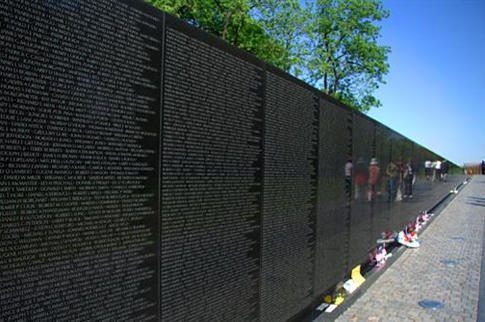As a volunteer and docent at the Vietnam Memorial Wall in Washington, D.C., for six years, Bill Shugarts has read names on the wall countless times.
But tomorrow he'll spend close to a half hour reading 30 of those names aloud, over a microphone, to men and women coming from all across the country to mark Veterans Day and the 30th anniversary of what may be the most famous war memorial in the country.
"It's an honor and a privilege," said Shugarts, who as a young lieutenant organized convoys for the Americal Division out of Chu Lai and later Da Nang. Shugarts expects it will be an "emotional" experience.
"It's the personalization, it's the names. ... And there's the enormity of the names -- 58, 283," he said. "It just hits you right between the eyes."
As many as 2,000 volunteers, from public officials, servicemembers and veterans to family members of veterans or citizens with no military connection are expected to take part in the marathon reading of the names of Vietnam War dead.
The days-long event is the fifth time all the names on the Wall have been read aloud, said Jenn Rowell, spokeswoman for the Vietnam Veterans Memorial Fund, the organization founded 30 years ago to build the memorial. The first time was November 1982, when the names were read at the National Cathedral as part of a weeklong National Salute to Vietnam Veterans
The names were also read as part of the memorial's 10-year anniversary in 1992, the 20th in 2002, and the 25th in 2007, she said.
Jan Scruggs, president and founder of the Vietnam Veterans Memorial Fund, told those gathered at the Wall on Thursday that reading the names recalls the individuals.
"For some of us, the reading of the names will bring back a story about that person when they served in the military," Scruggs, president and founder of the Wall and the Vietnam Veterans Memorial Fund, said in remarks on Thursday, when the readings began. "It might be a funny story, it might be a serious story. It might be an inspiring story. But whatever it is, it is a story that stayed with us all these years."
The first names were read by Hank Cramer, an American folk singer from Washington, and his son, Hank Jr. -- the son and grandson of Army Special Forces Capt. Harry Cramer -- who in 1957 became America's first Vietnam War casualty.
Another reader was former Nebraska Sen. Chuck Hagel who, along with his brother, Tom, served as an infantryman in Vietnam in 1968.
The men and women whose names are on the wall can no longer tell their stories, but those who served with them can help tell what their story was by relating their own experiences, Scruggs said in comments recorded and posted on the Stars & Stripes news site.
Shugarts said he believes the Wall is unique among war memorials for its ability to connect to those whose names are on it.
He has seen this in visitors who have come from all over the U.S. and overseas. It was never brought home so much, however, as on two occasions when he met and spoke with Vietnamese visitors. When they said they had served in the war, he asked if they had been ARVN -- soldiers of the Army of the Republic of Vietnam.
"No, they said they were VC," Shugarts said. Shugarts, who has made several trips to Vietnam since the war, was surprised but felt no anger or animosity toward country's one-time enemies.
"They asked if we minded if they paid their respects," he said. On both occasions, the former VC left a rose at the Wall, he said.
"It's pretty special," he said of the Wall. "It's one of the most enduring monuments."






























